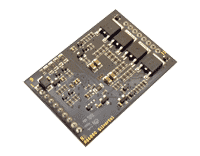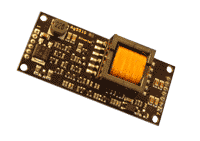- Home
- Symmetry Blog
- IEEE 802.3bt - The New 4 pair Standard of PoE
From Silvertel: "IEEE 802.3bt – The New 4 pair Standard of PoE"
About Symmetry Electronics
Established in 1998, Symmetry Electronics, a Division of Braemac, is a global distributor of electronic components and systems. Combining premier components and comprehensive value-added services with an expert in-house engineering team, Symmetry supports engineers in the design, development, and deployment of a broad range of connected technologies.
Exponential Technology Group Member
Acquired by Berkshire Hathaway company TTI, Inc. in 2017, Symmetry Electronics is a proud Exponential Technology Group (XTG) member. A collection of specialty semiconductor distributors and engineering design firms, XTG stands alongside industry leaders TTI Inc., Mouser Electronics, and Sager Electronics. Together, we provide a united global supply chain solution with the shared mission of simplifying engineering, offering affordable technologies, and assisting engineers in accelerating time to market. For more information about XTG, visit www.xponentialgroup.com.
Current Standards
Since its first release, in 2003, it became obvious that PoE provided great benefits however some applications were restricted by the power available. The first specification, called IEEE802.3af, allowed up to 12.95W at the Powered Device (PD) and the second, released in 2009 and called IEEE802.3af, allowed up to 25.5W. This allowed for 100m of cable between the Power Sourcing equipment (PSE) and the PD. The power could be supplied on the spare pair or the data pair which was referred to as Mode A or B.
| Standard | Power from PSE (W) | Power a PD | Cable Type | Mode |
| 802.3af | 15.4 | 12.95 | Cat 3 or 5 | A or B |
| 802.3at | 30 | 25.5 | Cat 5 | A or B |
It is important to note that the standards are backwards compatible i.e. an 802.3af PD can be used with an 802.3at PSE and an 802.3at PD can be used with an 802.3af PSE but with the power limited by what the PSE can supply.
PoE can also be defined by the Type where a Type 1 is an IEEE802.3af device and Type 2 is IEEE802.at device. Within each Type there are various classes that the PD presents to the PSE which defines the minimum power delivered to the PD and would allow the PSE to manage its power available.
| PoEType | Class | Current(mA) | PD per Pair (W) | PSE Power Per Pair (W) |
| 1 | 0 | 0 - 4 | 0.44 - 12.94 | 15.4 |
| 1 | 1 | 9 - 12 | 0.44 - 3.84 | 4 |
| 1 | 2 | 17 - 20 | 3.84 - 6.49 | 7 |
| 1 | 3 | 26 - 30 | 6.49 - 12.95 | 15.4 |
| 2 | 4 | 36 - 44 | 12.95 - 25.50 | 30 |
What 802.3bt brings
More Power - This new standard allows the transfer of at least 71W to the PD with the maximum cable length. This extra power is delivered across all four pairs which minimizes the losses in the cable. This extra power available allows more applications at higher power like smart LED lighting, Cameras with AI and larger digital displays. However with this higher power and faster data speeds, cable quality and electronic design now becomes an important factor when trying to achieve maximum power and error free data transmission.
Connected Devices -The new standard allows for this higher total power to be split across two separate PD devices from a single IEEE802.3bt PSE output. The PSE will check both pair sets to see if it’s connected to single or dual signature PD. A single signature PD connection will operate as you would expect, monitoring the overall power consumption and imbalance between pair sets. A dual signature connection allows the designer to have two individual PD devices within their system, monitored by a single IEEE802.3bt PSE, thus giving them the opportunity for 2 independent rails within their system whilst only using a single Cat5e cable. The independent monitoring on each pair set also allows for power saving in the end users device where one of the rails may choose to go into standby mode whilst the other rail may need to continue to operate at full power.
New classes and types - The increase of power is not implemented in one step the standard brings 2 new PoE types and 4 new classes for effective power management.
| PoEType | Class | Current(mA) | PD per Pair (W) | PSE Power Per Pair (W) |
| 3 | 4 | 0 - 4 | 12.95 - 25.5 | 30 |
| 3 | 5 | 9 - 12 | 40 | 45 |
| 3 | 6 | 17 - 20 | 51 | 60 |
| 4 | 7 | 26 - 30 | 62 | 75 |
| 4 | 8 | 36 - 44 | 71 | 90 |
Lower standby power –After powering the port the PSE monitors the current drawn is above a set limit, known as the Maintain Power Signature (MPS), to detect if the PD has been disconnected. The IEEE802.3bt is more energy conscious and has improved its MPS to allow a lower stand by power which is ideal to meet today’s needs.
In order to keep the port active, an IEEE802.3af or IEEE802.3at PD must draw approximately 10mA or a duty cycle of 30% from the PSE. With most systems, we would expect to see about 150mW of loss per port, so if we had multiple lighting systems on multiple ports, for example 10, this would equate to 1.5W of lost power when unit in standby. The new standard has changed this and now the PSE will only require a very conservative duty cycle of ~2%. This reduces the amount of power lost per port by a factor of 15. This is beneficial where devices can be put into sleep mode i.e. PoE lighting systems or security systems that may only be needed to be active during night time and turned off during the day.
Automatic Classification -Auto classification is a new system in which the PSE can automatically detect the actual maximum power drawn by the PD. The PSE will measure the maximum power drawn by the PD over a set amount of time and then assign this power to that port plus some margin.
Backwards Compatibility -As with 802.3at, the 802.3bt standard will be fully backwards compatible with the previous standards of PoE. This system, in theory, should work automatically with any PD (As long as the PSE has the means to supply the required power). In the scenario where an 802.3bt PD is plugged into a lower standard PSE, the device may turn on if the power consumed is within the PSE power limitations, but will fail to start or shutdown if its power is much greater than the PSE’s power capability.
802.3bt Applications
| * LED Lighting | * Industrial PCs | * Automated Teller Machine (ATM) |
| * LED displays | * POS terminals | * IoT access points |
| * Automated Teller Machine (ATM) | * Smart IP Cameras | * Automation Control Systems |
Considerations – When using higher power applications
As with every product produced, there must be considerations made. As the new standard is released and we start to see an influx of new designs, it is important to consider the thermal requirements of the PD. In this new age of technology, size is everything. Products and devices are getting smaller and slimmer, as such it is important to monitor and rectify the thermal implications of high power designs. Heatsinks and thermal management are a must and are more important than ever. With the amount of power almost tripling, internal temperatures of devices will rise much quicker. PD placing within the enclosure becomes a vital factor in being able to operate the device at its maximum operating power, such that maximum airflow and heatsinking can be achieved.
Summary
In conclusion 802.3bt, will bring a whole new avenue of opportunity to the world of PoE. Introducing new ways to improve LED lighting, smart homes and other connected devices. We will see new and more advanced security systems taking advantage of the new power limit. As the world continues to evolve and we develop more energy efficient devices, the list of applications for PoE will only increase.
Silvertel’s range of PoE modules will make the transition into the new standard easier than ever. With our 802.3bt compliant modules, implementation of 4 Pair PoE technology into your device will be seamless, easy and cost effective. They provide the complete solution using minimal external components.
Ag6800 - IEEE802.3bt PSE

Ag5800 - IEEE802.3bt PD (12/24V output)

